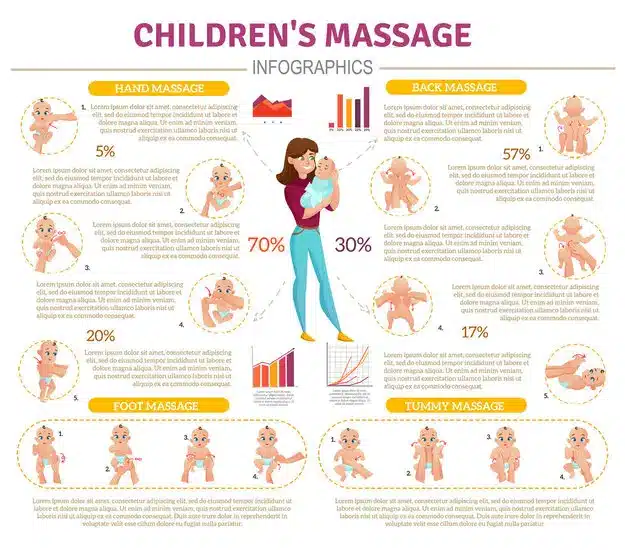Baby massage for sleep helps little bodies relax and settle before bed, turning bedtime into a calm ritual with steady touch and an easy rhythm. A few quiet minutes in a warm room can lower stress, ease tummy pressure, and create a dependable cue that night has started.
Baby Massage for Sleep Benefits and Science
A gentle routine before bed works with biology, not against it. Soft pressure and rhythmic strokes encourage the parasympathetic system, slow breathing, and smoother transitions to sleep. This relaxing pattern can also reduce bedtime protests by turning touch into a consistent signal for rest. Independent reviews and pediatric sources highlight touch and infant massage as supportive tools for soothing and sleep readiness.

Relaxation that sticks
The more consistent the flow, the stronger the association becomes. A short nightly session of baby massage for sleep can help settle the nervous system and soften that wired end-of-day energy.
Bonding and bedtime confidence
Warm hands, eye contact, and predictable steps build comfort. Over days, that pattern becomes a clear message: bath, lotion, baby massage for sleep, feed, story, sleep space. This steady order is often easier to maintain than long wind-downs. Guidance on safe, back-to-sleep positioning remains the anchor for any bedtime plan.
Benefits of infant massage
Baby massage for sleep delivers more than calmer bedtimes. The benefits of infant massage include better body awareness, steadier breathing, and an easy way to ease end-of-day fussiness. Gentle tummy work, an infant massage to relieve gas or a brief baby belly massage for constipation can reduce pressure and discomfort. Light strokes on the calves and massaging baby’s feet relax busy legs; a short foot massage for infants often becomes the favorite step. The quiet, face-to-face time builds connection, so protests at lights-out fade. With simple, consistent steps and a touch of baby oil massage if needed, evenings grow smoother and nights more restful.
Comfort for gassy tummies
Light abdominal work can ease trapped air and reduce wake-ups linked to discomfort. The Smart Sleep Coach resource on helping a gassy newborn sleep walks through positions and soothing steps that pair well with massage.
When to Try Baby Massage for Sleep
A short note before diving into techniques: baby massage for sleep lands best in the evening flow when the stomach is not full and the room is warm and quiet.
Ideal timing in the evening routine
Aim for the window between late play and the last feed. Ten to fifteen minutes is plenty for a calm, consistent session. This timing also fits easily with a simple eat-play-sleep rhythm many families follow.
Signs to begin or pause
Ready signs include soft eyes, relaxed limbs, and steady breaths. Time to pause if arching, hiccups after a big feed, or that glassy overtired stare appears.
Oils and skin-friendly choices
A few drops of a baby-safe oil reduce friction. A quick patch test helps check sensitivity. A baby oil massage should leave skin comfortable, not slick. Keep a towel nearby to dry hands between areas.
Core Infant Massage Techniques for Bedtime
Each section uses slow, predictable strokes with medium pressure firm enough to avoid tickles, gentle enough to relax. These methods can be adapted to age and mood and support baby massage for sleep.
Legs and feet
Start here to set an easy tone for a sleeping massage.
- Glide both hands from thigh to ankle in long strokes using gentle infant massage techniques.
- Circle each ankle with your thumb and forefinger for a simple massage for infant routine.
- For massaging the baby’s feet, press the pads of the thumbs from heel to toe. Pause at the center of the sole for a calming hold.
- Add a focused foot massage for infants by tracing a line under the toes and giving each toe a light pinch-release.
Tummy care
Belly work is the star move for bedtime comfort and infant massage to relieve gas.
- Warm the belly with a resting hand for a slow five-count.
- Stroke clockwise to follow the colon.
- Use three small circles on the lower left quadrant to help move air along.
- For tummy massage for constipation – baby, widen the circles slightly and finish with downward strokes from ribs to pelvis.
- As part of baby belly massage for constipation, try the simple I-L-U pattern: I down the left side, L across the top then down, U from the lower right up and around. The Smart Sleep Coach guide on massage to help baby poop explains these patterns in detail, helpful for massage for baby constipation and baby massage for sleep.
Chest, arms, and back
- Chest: trace open butterfly wings from center outward, never pressing on the sternum.
- Arms: milk from shoulder to wrist with steady strokes; rotate wrists gently.
- Back: during supervised awake time, place the baby on the tummy and trace small circles along the paraspinal muscles, never on the spine. Many families find this to be the quietest moment of baby massage for sleep.
Face and scalp
- Brow sweep: glide from center to temples ten times.
- Cheeks: small outward circles along the cheekbones.
- Scalp: a feather-light newborn head massage with fingertips often brings eyelids down.
- For head shape concerns, a gentle baby head massage for a flat head routine can be soothing, while awake tummy time remains the active support during the day and supine sleep remains safest at night.
Full-Body Massage Routine for Better Sleep
This flow avoids start-stop patterns that can re-energize the body.
- Feet and legs for 2–3 minutes
- Arms and hands for 2 minutes
- Chest for 1 minute
- Tummy for 2–3 minutes, always clockwise
- Back for 2 minutes during awake tummy time
- Face and scalp for 1–2 minutes
A timer is optional. Slow breathing often sets the pace. The full routine fits a 10–15 minute slot and pairs well with bath and a short story. Families using a predictable day pattern can check the eat-play-sleep schedule overview for timing context.
A quick note on reflux: keep the flow gentle, offer smaller frequent feeds, hold upright after eating, and always place baby flat on the back for sleep, as clinical guidance suggests.
Baby massage for sleep remains effective even when the total time is shortened on busy evenings.

How many types of massage routines are there
Three practical options cover most households.
- Quick calm, about 5 minutes: legs and feet, tummy, face.
- Standard, 10–12 minutes: the full sequence above.
- Comfort focus, 8–10 minutes: extra tummy and back time for sensitive bellies.
Teaching infant massage at home
Show hands, ask permission with a smile, wait for an inviting look, start with feet. Over a week, the set order becomes familiar. Short sessions often outperform long ones. Local classes and certified instructors follow similar methods with small variations, so continuing at home feels natural.
Tips for a Successful Massage
A short scene-setter helps each session start smoothly. Baby massage for sleep works best in a space that feels calm and predictable. Baby massage for sleep also blends well with a warm bath and a short story, creating a steady evening rhythm that takes the guesswork out of wind-down time.
Room setup, temperature, lighting, and sound
- Keep the room warm enough that a diaper-only setup still feels cozy.
- Dim the lights or use a soft bedside lamp to prevent a second wind.
- Lay a towel on a firm surface; a rolled washcloth under the ankles can improve comfort during tummy strokes.
- If background noise is unavoidable, gentle white noise can smooth over sudden sounds.
- Keep wipes and a spare towel nearby to dry hands between oil applications.
- Trim nails and remove rings or bracelets to prevent scratches during strokes.
Pressure, pace, and reading cues
- Medium pressure settles the system more than feather-light brushes during baby massage for sleep.
- Keep the pace slow and even, matching the rhythm of calm breathing for a sleeping massage.
- If fussing starts, pause with a still hand on the belly, hum a simple tune, and resume after a few slow breaths using gentle infant massage techniques.
- During growth spurts or busy days, a shorter set keeps the rhythm steady without overstimulation. Baby massage for sleep is important with massage for infant routines baby massage for sleep.
Safety notes and when to skip
- Skip tummy work right after feeds; allow time for digestion first (infant massage to relieve gas works best later).
- Avoid any irritated areas or healing skin; for eczema-prone spots, use the pediatrician-recommended emollient and lighter strokes around the area during baby massage techniques.
- Watch for signs of discomfort such as arching or splaying fingers; shorten the session if these appear in massage for infant sessions.
- Keep oils away from the mouth and hands to prevent accidental ingestion during a baby oil massage for baby massage for sleep.
- Ensure the surface is stable and never leave the baby unattended during the session in sleeping massage time.
- For reflux or persistent gas, supportive holds and frequent burping help; Smart Sleep Coach’s reflux sleep guidance outlines positioning and feeding adjustments that pair well with massage, helpful alongside infant massage to relieve gas and massage for baby constipation when needed.
Troubleshooting Common Sleep Roadblocks
Baby massage for sleep can be adapted on the fly to match energy and comfort levels.
Overtired signals and a quick reset
Red brows, frantic rooting, and rapid kicking often signal overtiredness. In those moments, shorten the flow to feet and face, dim the lights, and transition to the sleep space and important for baby massage for sleep.
Gas, reflux, or constipation support
Clockwise tummy strokes and gentle knees-to-belly compressions help move air. For bowel-movement support, the massage to help baby poop walkthrough shows belly wheel techniques and when to keep sessions short after feeds.
Blending massage with a bedtime routine
A steady order reduces debate: bath, lotion, baby massage for sleep, feed, brief wind-down, bed. Routine consistency often trims settling time and improves night-to-morning flow. For families building daytime predictability, the eat-play-sleep schedule primer offers helpful pointers.
Growth spurts, travel, and schedule bumps
Some weeks bring extra hunger, longer wake windows, or location changes. On those nights, keep the sequence but trim each section to a few passes. Add a longer hand-on-belly hold, then move to the sleep space before the “tired-and-wired” window hits. After travel, return to the usual order the very next evening to rebuild the cue quickly. A simple note in a sleep log can track which sections calm the fastest during these phases.
Expanded Techniques Library
These baby massage techniques add variety without making sessions complicated.
Legs and feet: extra calmers
A heel-to-toe thumb press encourages deep breaths. Toe squeezes with a two-count hold finish the set. Plenty of households nick-name this the lights-out pass for good reason.
Tummy and chest: comfort flow
Keep strokes slow and even. The sunshine sweep across the chest goes outward only, then moves into circular belly work. This is also where infant massage to relieve gas shines. If constipation is frequent, add more clockwise circles and brief downward strokes.
Back, face, and scalp: settling finish
Trace circles along the paraspinal muscles, then switch to facial passes and scalp strokes. Minimal chatter prevents a second wind. End with a two-hand still hold on the forehead before laying the baby down.
Oils and lotions: quick guide
A neutral, fragrance-light option keeps skin comfortable. Warm a few drops in the hands first to prevent a startle. Any massage for an infant plan should prioritize skin comfort as much as technique.
Baby massage for sleep fits well alongside tummy time milestones and head-control progress during the day. Related development pieces on tummy time and head-control timing can help align massage with daytime activity.
The Bedtime Playbook: A Sample Week
Night 1–2: Quick calm with legs and feet, tummy, and face. Keep the rest of the evening routine simple.
Night 3–4: Standard flow. Watch for the sections that bring the longest sighs.
Night 5–7: Standard flow plus one comfort-focus night if gas flares.
Improvements often show up as shorter settling times, fewer wake-ups related to gas, or easier resettles. A simple notebook or tracking app makes patterns easier to see. Baby massage for sleep can then be adjusted to lean into the most relaxing sections.
FAQs
How long after feeding to start a sleeping massage
Ans: Wait 30–45 minutes before starting a sleeping massage to avoid spit-up and discomfort for a better baby massage for sleep.
How often to use infant massage techniques for bedtime
Ans: Once daily is enough. On busy nights, a 5-minute flow still helps.
Which oil is best for a baby oil massage at night
Ans: A light, fragrance-free baby oil or pediatrician-approved emollient works well. Patch test first.
Does massaging baby’s feet help faster settling
Ans: Yes. Massaging baby’s feet with slow heel-to-toe presses often reduces fidgeting before lights-down.
Can massage for infant care be done during mild colds
Ans: Yes, if comfortable and fever-free. Keep it short and skip tummy work right after medicine or feeds.
Is newborn head massage safe every night
Ans: Yes, with feather-light touch. Pair with awake tummy time; keep sleep on the back.
Will baby head massage for flat head change head shape
Ans: Massage soothes scalp muscles but does not reshape the skull. Position changes and tummy time matter most.
What if gas is the main issue—use infant massage to relieve gas or burping
Ans: Use both. Gentle belly circles plus burping after feeds address air from two angles.
Best moves for massage for baby constipation in the evening
Ans: Clockwise circles, I-L-U strokes, and brief downward sweeps. Stop if discomfort increases.
When to choose baby belly massage for constipation over full-body work
Ans: On fussy nights, do a short leg-and-belly set first, then add the rest only if calm.
Are there signs to stop baby massage for sleep mid-session
Ans: Yes. Arching, stiff arms, or frantic crying. Pause, cuddle, or try a shorter routine later.
How many types of bedtime routines are practical
Ans: Three: quick calm, standard, and comfort focus. Rotate based on energy and tummy needs so its important of baby massage for sleep.
Can teaching infant massage involve grandparents or caregivers
Ans: Absolutely. Share the sequence and pressure cues so everyone follows the same routine.
Any tweaks for preemies or sensitive skin during massage for infant care
Ans: Use lighter pressure, extra warmth, and shorter windows. Confirm product choices with the care team.
Where does chest work fit within baby massage techniques at night
Ans: After legs and arms, before tummy. Gentle outward sweeps only, no pressure on the sternum.
Does a sleeping massage replace a bath or story
Ans: No. It complements the routine. Keep the order consistent for a clear sleep cue.




